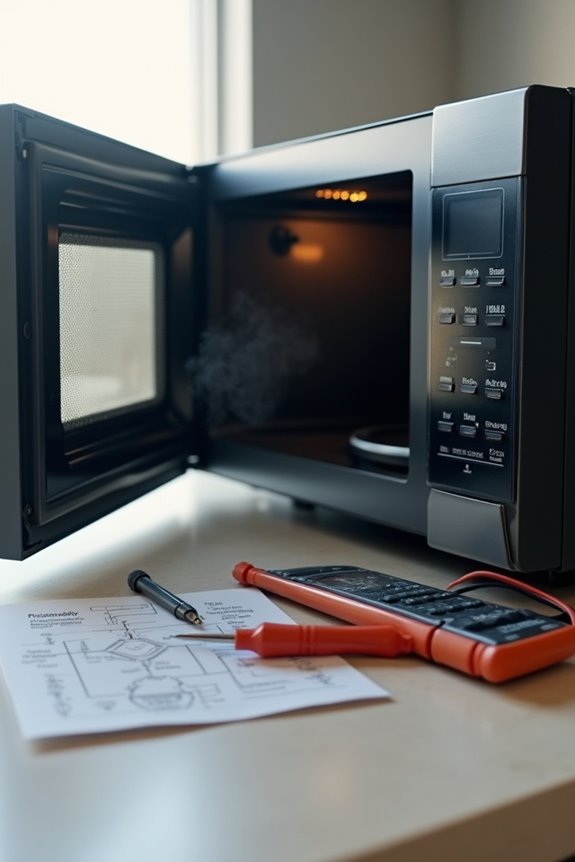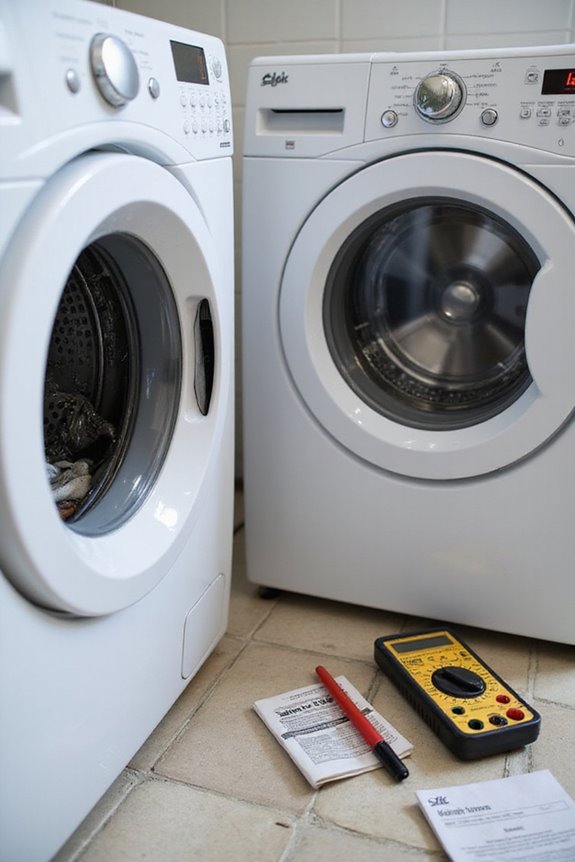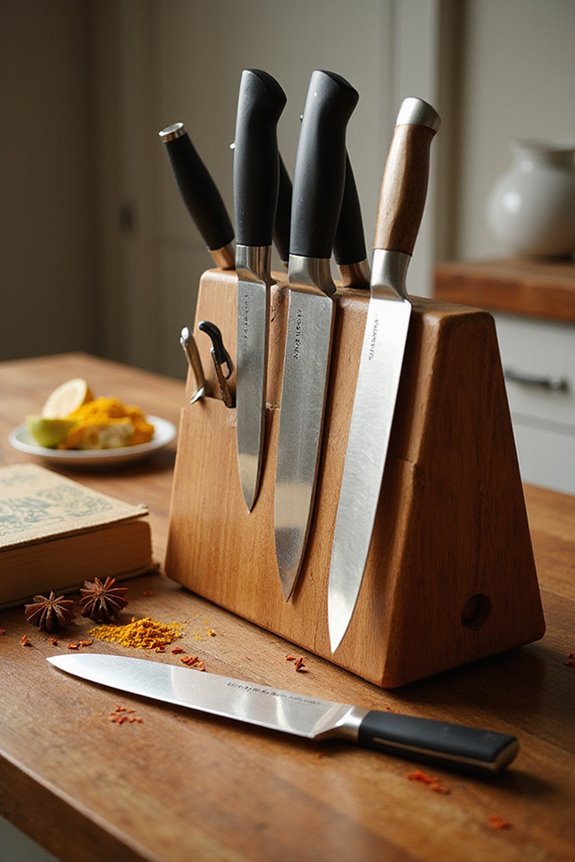Troubleshooting common appliance problems can feel magical! Here’s how we can tackle them. First, let’s check power issues by testing outlets—115–120 volts are the goal! Next, for a dishwasher that’s down, we should inspect door latches and clean out filters. For fridges, make sure the thermostat’s set right (32ºF to 40ºF) and check those gaskets. Oh, and don’t forget to keep our appliances clean for delightful performance. Stick around to discover even more tips and tricks!
Key Takeaways
- Start by checking the power supply; test outlets and inspect cords for damage to ensure proper electrical function.
- For dishwashers, check door latch alignment, clean filters, and inspect gaskets for potential leaks.
- Confirm that refrigerators are plugged in, verify thermostat settings, and clean condenser coils for efficient cooling.
- Address common microwave issues by checking for blown fuses, ensuring the plate is properly aligned, and listening for unusual noises.
- For washing machines and dryers, clear clogged hoses, clean lint traps regularly, and ensure proper ventilation for effective operation.
Power Issues and Electrical Checks
When we explore troubleshooting our appliances, the first thing we usually need to tackle are power issues and electrical checks. Let’s get started with some engaging steps!
- Outlet Testing: Plug in a known-working device to see if the outlet’s got juice. Aim for 115–120 volts; anything less might be a sign of trouble!
- Circuit Inspection: Check the circuit breaker panel — any tripped breakers? Reset them!
- Power Cords: Inspect for frays or damage. A healthy power cord is as crucial as a gingerbread cookie at a holiday feast!
Also, keep in mind that energy efficiency in kitchen appliances can significantly impact not just performance but also overall functionality.
If we follow these steps, we’re setting a delightful foundation for successful appliance troubleshooting. Together, we can make sure our trusty devices continue to serve us well!
Troubleshooting Dishwasher Malfunctions

Have you ever wondered why your trusty dishwasher isn’t working its cleaning magic? Let’s explore a few common malfunctions that could be spoiling our sparkle.
Door Latch Issues
- If the door won’t close, check for misalignment or a latch gunked up with food.
- A sticking rack can also keep that door from latching smoothly.
- Don’t forget the rubber gasket; wear can lead to leaks and less fun!
Drainage Problems
- Standing water? Clogged filters are often the culprit. Let’s clean those out regularly!
- Also, inspect drain pipes; they may need a pro for tricky clogs.
- Using eco-friendly cleaners can help maintain your dishwasher and ensure a healthier environment.
Together, these simple checks can save our dishwashing dreams from disaster. Happy cleaning!
Addressing Refrigerator Cooling and Leakage Problems

Addressing refrigerator cooling and leakage problems can feel like a culinary adventure gone awry, but don’t worry—together, we’ll troubleshoot like pros!
Check Power and Settings
First, let’s verify our fridge is plugged in. An unnoticed unplugged cord can turn our delightful meal prep into a soggy disaster! Check the thermostat settings (32ºF to 40ºF is just right) and verify it clicks when adjusted.
Maintain for Efficiency
Next, let’s dust those condenser coils! A little cleaning goes a long way to boost cooling efficiency, and ensuring that proper maintenance can help prolong the life of your appliance.
Inspect for Leaks
Lastly, keep an eye on the door gaskets—if they’re damaged, warm air sneaks in. Regular refrigerator maintenance keeps our culinary charm alive! Let’s keep our fridge happy, so we can whip up delightful meals!
Common Microwave Oven Faults

Microwaves can be magical kitchen tools, helping us prepare delightful meals in a flash, but sometimes they throw a little curveball our way! Here are some common faults we might encounter:
- Plate Not Turning: This could be due to misalignment, a faulty turntable motor, or defective guide rollers.
- Microwave Won’t Start: A blown fuse or a defective door switch could prevent it from powering on.
- Strange Noises: Rattling noises may signal loose parts, while buzzing can point to magnetron issues.
- Light Not Working: A burnt-out bulb is often to blame, and it’s usually easy to replace!
For effective microwave maintenance, verify we regularly check these issues. Additionally, ensuring our kitchen equipment compatibility with various cooking techniques can help prevent misuse that may lead to faults. If they persist, don’t hesitate to plunge into microwave troubleshooting or call a professional!
Issues With Washing Machines and Dryers

After enjoying those delightful microwave meals, it’s time to tackle another magical kitchen team: our washing machines and dryers! We all dread those moments when our washer won’t drain or our dryer overheats. Let’s immerse ourselves in some common issues.
Washer Drainage
- Check for clogged hoses. Tiny socks and gunk can be sneaky!
- Moving the washer might be required, but it’s worth it for smooth drainage.
Dryer Overheating
- Clean those lint traps regularly! It feels like a chore, but it prevents overheating.
- Verify vents are clear to keep our clothes toasty but not too hot.
- Remember to maintain your eco-friendly kitchen tools to avoid additional maintenance issues.
If problems persist, we shouldn’t hesitate to call a pro. Let’s keep our magical team running smoothly, folks!
Fixing Stove and Cooking Appliance Problems
Getting our stoves and cooking appliances in tip-top shape can feel like preparing for a big holiday feast—there’s a bit of magic involved! Let’s tackle stove ignition issues by guaranteeing no food or grease blocks our burners. A quick clean can work wonders, just like a chef’s secret spice! If the flames are wobbly, think “burner maintenance”—clogged ports need some gentle clearing with a thin wire.
For electric stoves, we should guarantee burners are snug in their sockets. Don’t forget to check those circuit breakers too! If something feels off, replacing worn-out elements often does the trick, just like a failed soufflé can lead to a delightful cake. Enhancing our cooking experience can come from investing in energy-efficient features, ensuring both functionality and savings. Happy cooking, everyone!
Identifying and Resolving Short-Circuit Issues
When it comes to keeping our kitchens safe and delightful, identifying and resolving short-circuit issues can feel like unwrapping a gift during the holiday season—full of surprises! Let’s explore some common short circuit causes, like damaged wiring or pesky pests nibbling away at cords. We might also notice some short circuit symptoms, such as flickering lights or the faint smell of burning plastic.
To tackle this, we should first turn off power, then inspect our outlets and appliances for loose connections or moisture. If things get tricky, don’t hesitate to call a licensed electrician! Remember, keeping our appliances safe is a team effort. Together, we can guarantee our kitchens are both magical and secure!
Maintaining Appliance Performance Through Regular Cleaning
Maintaining our appliances can be a delightful journey, especially since a little regular cleaning goes a long way in keeping everything running smoothly! By sticking to our cleaning schedules, we can prevent dirt and grime from accumulating. Just like spring cleaning boosts our spirits, a clean appliance efficiently operates and saves us money!
- Clean condenser coils on our refrigerators twice a year.
- Keep filters and vents clear to reduce energy consumption.
- Don’t forget, appliance inspections during cleaning help spot problems early!
With these habits, we’ll extend our appliances’ lifespans and guarantee they stay reliable. It’s truly a magical experience, transforming our kitchen into a flawless, cozy haven while we whip up delicious meals together!
Ensuring Proper Appliance Installation and Setup
Ensuring our appliances are properly installed and set up is essential for their delightful operation and longevity! We can start by following the installation guidelines provided by the manufacturers. Remember, when it comes to appliance leveling, it’s like placing a Christmas ornament just right—every detail matters for your machine’s performance!
- Check that the electrical outlets match your appliance needs.
- Verify water supply connections for dishwashers and washing machines.
- Don’t forget to leave enough space for ventilation!
A professional installation is often the best choice. It’s like having a superhero on your side to prevent potential disasters! Let’s keep our homes safe and our appliances running smoothly, so they can work their magical wonders for years to come.
Safety Measures for Appliance Repair and Troubleshooting
As we plunge into the world of appliance repair and troubleshooting, it’s essential to remember that safety should be our trusty sidekick! First things first, let’s gear up with the right safety gear. Always unplug your appliance before getting started to dodge any electric shocks.
Next, we should keep a clean workspace—think of it like preparing a delightful feast! Guarantee your area is dry and free from clutter.
Finally, let’s not forget about emergency preparedness! Have a fire extinguisher and first aid kit handy, just in case. If anything feels uncertain, it’s best to leave complex repairs to the pros. Remember, a little caution makes this magical journey safe and sound!
Frequently Asked Questions
How Can I Prevent Future Appliance Issues?
To prevent future appliance issues, we should commit to regular maintenance and consider appliance upgrades. Together, we can guarantee our machines run efficiently, enhancing our home experience while reducing potential headaches and costly repairs down the road.
When Should I Call a Professional for Repairs?
We should call a professional when our appliance shows signs of distress, especially if it’s under halfway through its lifespan. Repair costs can escalate quickly, and timely expertise can save us from bigger problems later on.
What Common Household Items Can I Use for Cleaning Appliances?
When cleaning our appliances, we can rely on baking soda and vinegar solutions. They’re natural, effective, and safe for our homes, helping us tackle odors and grime together without harsh chemicals. Let’s make cleaning enjoyable!
How Do I Know if Parts Need Replacement?
To identify parts needing replacement, we should analyze symptoms together. Unusual noises, performance drops, or visible damage often indicate issues. By examining these aspects, we can collectively determine which parts require our attention and care.
Are There Warranties for Appliance Repairs?
We’ve all wondered about warranty coverage for appliance repairs. Typically, warranties can help offset repair costs, but it’s essential to read the fine print and understand what’s included to avoid unexpected expenses.





